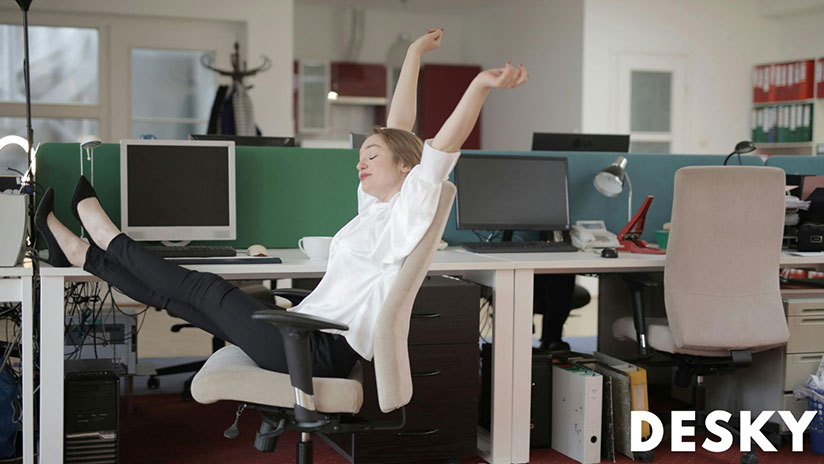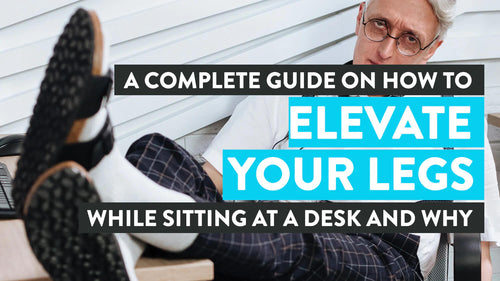
News
Fitness Experts Advise On Ways To Stay Fit When You're In A Sedentary Job
Hayden AdamsIf you’re not battling traffic or commuting on public transport, you’re sitting at a desk for long periods of time.
Either way, it’s a recipe for sore, aching muscles, painful joints, and, as we’ll see, potentially a whole host of other medical conditions.
Of course, having the right ergonomic work desks and stations goes a long way to helping with any aches and pains that arise during the course of a long working day, but there are other mitigating steps we can take too.
Some people actively enjoy the gym and find it a pleasure to get in there before and after work to move their bodies and get the endorphins pumping.
For some of us, it’s just not possible—it might be down to cost or a genuine dislike of that kind of environment. It doesn’t mean you can’t exercise. There are gentler, kinder ways of keeping fit that can make you feel great without the cost if you’re stuck in an office for 40 hours a week.

We’ve got together with some experts who’ll walk us through (see what we did there?) some of the ways you can stay fit when you’re in a sedentary job, and they’ll also tell us about the importance of gentle movement every day to keep us supple and trim.
What are some of the negative effects of sitting at a desk all day?
“Sedentary lifestyles are extremely common, but it takes a toll on health and productivity. Our bodies are built to move and be in regular action, and when it don't, you risk the following health ailments:As your blood flows slower and your muscles are burning less fat, there’s a higher risk of fatty acids clogging your heart.
The pancreas produces more insulin when sedentary, which could lead to diabetes. The efficiency of your body when dealing with sugar is affected by how physically active you are.
It’s believed that those who are sedentary are more at risk of various cancers, as the antioxidants in your body aren’t getting a boost from movement. These antioxidants are known to target potentially cancer-causing free radicals.” Sophie Saint writing for MoveGB
How much exercise do you need to do to offset your desk job?
“In 2020, a meta-analysis of nine previous studies(5), using data obtained from fitness trackers and feedback from 44,370 participants around the world, suggested that about 30-40 minutes of moderate to vigorous physical activity should offset ten hours of sitting.
If that feels unachievable, don’t despair, as more recent research(6), suggests that only 22 minutes of exercise is enough. This later study, published in October 2023 in the British Journal of Sports Medicine, set out to determine exactly how much sedentary time was associated with a higher risk of early death—and how much corresponding physical activity was required to offset that risk.
 As part of the study, around 12,000 people from Norway, Sweden, and the U.S. wore fitness trackers for at least four days each week, over a period of at least two years. Comparing the activity data with death registries and medical outcomes, the results showed that participants who exercised for less than 22 minutes a day had a 38% higher risk of death from any cause.
As part of the study, around 12,000 people from Norway, Sweden, and the U.S. wore fitness trackers for at least four days each week, over a period of at least two years. Comparing the activity data with death registries and medical outcomes, the results showed that participants who exercised for less than 22 minutes a day had a 38% higher risk of death from any cause.
Those who undertook 22 minutes of exercise or more each day had better health outcomes and typically had a longer lifespan.” Kerry Beeson BSc (Nut Med) Nutritional Therapist & Metabolic Balance Coach writing for PrepKitchen
Tell us how we can move more whilst we’re at our desks.
“We’ve talked about the benefits of moving every day before, but when you’re living behind a desk these are even more important. You’re being inactive for long periods every day – try balancing it out with a little bit of active, healthful movement every single day.
Finding a way to get some movement in at work – even if it’s simple like a walk around or a bit of desk stretching – can help. Get yourself up every 30 or 60 minutes on the dot to take a short walk around, even if you’re just going to get some water. Unbroken periods of sitting are worse for health because posture declines over time.
Activity, even walking, helps re-activate the muscles and keeps you conscious of desk posture. A short walk to break it up could be all it takes to help keep you active and keep those muscles switched on.” Beth Giddings with medical review by Sian Baker Dip ION mBANT mCNHC writing for The Health Hub.
Can you give a couple of examples of exercises that people in sedentary jobs might be able to do at their desk?
"While nothing can beat doing a proper exercise program involving free-weights and cardio, there are some great exercises you can do at your desk to tide you over until you can get to the gym.
Squats, shoulder, neck, and back stretches are going to be some of the best choices for those with a sedentary job. Give this quick desk workout a try, and we guarantee you will feel better and be more productive throughout your work day!
{{ spec_dual_bamboo_desk }}
Stand up from your chair, then lower yourself back down until your butt lightly touches it. Repeat for 3 sets of 10 reps with a one-minute break. Sit tall and roll your shoulders forward in a circular motion, then reverse the direction, doing 10 reps in each direction. Gently tilt your head to one side, bringing your ear towards your shoulder, until you feel a stretch along the side of your neck.
Hold for 15-30 seconds, then switch sides. Finally, sit upright in your chair and twist your torso to one side, placing one hand on the back of the chair and the other hand on the opposite thigh. Hold the twist for 15-30 seconds, then switch sides.” Troy Teebom, Owner kurstudios.com
What simple fitness tips can you offer for someone in a sedentary job?
Some of my quick and affordable tips to stay fit in our new era of Zoom meetings and remote working:
1) If possible, eat healthy, well-balanced small snacks and meals throughout the day. Then, when it comes time for a lunch break, take a walk/bike ride/quick trip to the gym. Even if you are short on time, walking for 10 minutes helps! It can be down the hall or around the block. Stay active during your break time!
2) Carve out 5–10 minutes every 2-3 hours to move. It can be a few stretches or some bodyweight exercises. If you have the space (and privacy) do some lunges or squats. No equipment is needed! Set goals: 20 lunges in 2 minutes and then back to work!” Lisa Cargill The FEST Team, FitnessFest.Org
Could you recommend two exercises people in sedentary jobs would benefit from
“1. There are certain parts of the body that tend to hold physical tension when you are mentally stressed. Stretching these areas 1-3 times throughout the day can help relieve physical pain brought on by stress. First take your right arm up and over your head so your fingertips are touching your left temple. Gently pull your head towards your right shoulder. Take 3 deep breaths (at least 4 second inhale and 4 second exhale). Stay in that position and slightly lower your chin to your chest and repeat with 3 deep breaths. Gently return your head to an upright, neutral position and switch sides.
2. Something as simple as standing for 1 minute every hour (and taking your eyes off your monitor) can help boost blood flow and circulation. This will help re-energize your mind and body! Don't forget to stay hydrated - water helps you feel full and energized, and it improves focus.”Courtney Fickes, Certified Personal Trainer wellteamculture.com
What yoga poses can help with staying fit in a remote office space?
“I love doing down dog pose to fully stretch my body after sitting at a desk all day long.
Triangle pose is another great pose to reset the body because of the twisting motion - it is energizing, balancing and helps improve focus.” Lindsey W Co-Chief Retreat Finder retreatfinder.com
What daily habits do you suggest to minimize sedentary lifestyle risks?
Unfortunately with the increase in remote work it has meant the increase of time in front of computers and electronic devices. The increase in screen time has taken a serious toll on posture and our underlying spinal structure. Left untreated, this can not only lead to the unattractive cosmetic changes we associate with poor posture and general soreness/tightness but it can have some serious repercussions over time such as losing our spinal mobility and range of motion causing us to slow down and age quicker, the wear and tear of the spinal joints (spinal arthritis) and the wearing down of our spinal cushions or discs (degenerative disc disease).
Some of these conditions such as spinal arthritis and degenerative disc disease cannot be reversed once they start but they CAN be slowed down or stopped with treatment and postural exercises. But the thing to really know is that they can be prevented altogether if detected and treated early by chiropractic professionals trained in and using the techniques to help with structural spinal health.” Dr. Darrin Redinger of Illinois Spinal Care of Elmhurst





